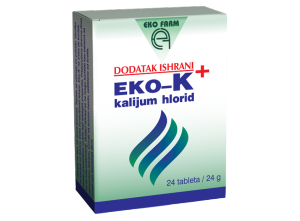The role of potassium in the human body
Natural sources of potassium
Recommended intake of potassium
Potassium deficiency
Populations at higher risk of developing potassium deficiency
Potassium deficiency treatment
Potassium dietary supplements
The role of potassium in the human body
Potassium is a mineral widely present in the human body, necessary for the functioning of many tissues such as nerve, muscle and heart. It carries a positive charge and it is the most common positive ion (cation) within our cells. In addition to that, potassium participates in the forming of electrical impulses in human cells and it belongs to the important group of electrolytes such as sodium, calcium, magnesium, chloride, phosphate and bicarbonate ions. Potassium maintains the structure of cytoplasm (cell’s interior), activates cell enzymes and is essential for cell excitability. Along with other cations, potassium influences the activity of all tissues, providing nerve conduction, muscle contraction, heart rate, blood volume regulation, and renal function. Beside all this, potassium has a very important role in protein and carbohydrate synthesis, as well as acid-base balance.
Reliable scientific sources confirm the great importance of potassium for proper functioning of almost all vital organs and physiological functions. Among them all, there are three systems that stand out:
- Blood pressure – potassium favors sodium renal excretion, and has a negative effect on its absorption (uptake into the bloodstream) from food and drinks. This is important if we know that increased sodium levels increase water retention, consequently triggering higher blood pressure levels in the body. Therefore, people who consume a lot of sodium, mainly through the kitchen salt, are advised to consume potassium rich diet or dietary supplements containing this mineral.
- Bones – effect of potassium on the skeletal system is still being investigated, but the results so far confirm that a balanced dietary intake of potassium has a positive effect on the bone mass preservation. Potassium achieves its physiological bone-preserving effect indirectly, preventing the loss of calcium from the bones to a certain extent, and inhibiting its renal excretion. It is believed that calcium is ‘leaving’ the bone in order to neutralize moderate metabolic acidosis (an acidic environment), which is physiologically created in the body after continuous consumption of food rich in meat and cereals, and poor in fruit and vegetables.
- Kidneys – potassium concentrations in blood and tissues are regulated by the kidneys, since it is excreted from the body via urine. Potassium can have a positive or negative effect on kidneys, depending on their functional state. If the kidneys are healthy, they will easily maintain potassium blood concentration level in state of equilibrium. Scientific data suggest that potassium acts even as a nephroprotective, protecting the kidneys from the formation of calcium-oxalate sand and stones. However, if the kidney function is at some level impaired, potassium blood concentration could grow and potentially cause a change of acid-base equilibrium, irregular heartbeat, or muscle and nerve excitation.
Natural sources of potassium
Popularization of highly processed foods in the daily diet at the expense of decreased intake of fresh fruit and vegetables, led to reduced potassium intake in general population. This is one of the main reasons why the world’s leading medical institutions consider potassium a deficient nutrient. Western diet, as well as diet in Serbia, promotes increased sodium intake with potentially harmful adverse effects on the cardiovascular system. Therefore, people who consume larger amounts of table salt are particularly advised to eat potassium rich foods, and use dietary supplements if necessary.
Table 1 provides an overview of potassium content in different food sources, expressed on a standard serving/portion.
Table 1: food sources with different potassium content
| food source | standard portion | potassium content (mg) (mg) |
| potatoe, roasted | 1 medium size | 738 |
| prune juice | 1 cup | 707 |
| carrot juive | 1 cup | 689 |
| tomato paste | 1/4 cup* | 664 |
| white beans | 1/2 cup | 595 |
| potato juice | 1 cup | 556 |
| yogurt | 1 cup | 531-579 |
| tomato puree | 1/2 cup | 549 |
| sweet potato | 1 medium size | 542 |
| orange juice | 1 cup | 496 |
| bananas | 1 medium size | 422 |
| skimmed milk | 1 cup | 382 |
| peas, boiled | 1/2 cup | 217 |
| corn, boiled | 1/2 cup | 162 |
| cauliflower, boiled | 1/2 cup | 89 |
*Cup represents the amount of liquid/solid food sources, equivalent to a volume of 250ml
As indicated in Table 1, highest amounts of dietary potassium could be found primarily in fresh fruits and fresh/boiled vegetables. Potatoes stand out as one of the richest dietary sources of this mineral, but it should be pointed out that highly salted potatoes are not a good option due to excess sodium.
Upper tolerable limits for dietary potassium intake are not established, since it is almost impossible to reach potentially harmful concentrations of potassium in the body through a balanced diet.
Recommended intake of potassium
Recommendations for potassium intake have been set by various national agencies. According to the U.S. Food and Nutrition Board of the Institute of Medicine, Recommended Dietary Allowances (RDAs) for potassium represents the average daily intake level that is sufficient to meet the daily requirement of 97% -98% of the healthy population. Table 2 shows the current potassium RDA values in relation to different age groups determined by this American Institute.
Table 2: Recommended daily intake of potassium in different age groups
| age | RDA (mg) |
| 0-6 months | 400 |
| 7-12 months | 700 |
| 1-3 years | 3000 |
| 4-8 years | 3800 |
| 9-13 years | 4500 |
| 14-18 years | 4700 |
| ˃19 years | 4700 |
| lactation | 5100 |
By comparison, recommendation in Serbia is a bit different. It follows the current Guidelines on the sanitary safety of dietary products, which provide a slightly lower recommended daily intake of potassium for adults – 2000 mg / day.
Potassium deficiency
Potassium is eliminated from the body largely by renal excretion, and moderate by sweating through the skin. Kidneys maintain the equilibrium concentration of potassium in the body, but only if they are healthy. In people with impaired renal function, the amount of potassium rises, leading to the development of hyperkalemia (increased amount of potassium in the blood). This could strongly affect important organs such as heart and muscle. On the other hand, the use of certain drugs such as diuretics that expel excess fluid from the body, frequent vomiting and diarrhea, as well as working in high ambient temperatures, may lead to an increased loss of potassium and consequently hypokalemia (a decreased amount of potassium in the blood). Mild hypokalemia is often asymptomatic and usually remains undetected. The first visible sign of potassium deficiency are muscle cramps and numbness, followed by a feeling of fatigue. Further loss of potassium is accompanied with more severe symptoms such as muscle paralysis, which leads to impaired function of three key tissues – nervous, muscle and heart. If not treated on time, hypokalemia can have a life-threatening outcome.
Populations at higher risk of developing potassium deficiency
People with preserved renal function and healthy diet rich in fruits and vegetables have little chance to develop potassium deficiency. However, in some conditions potassium loss is so severe that it exceeds its food intake. These conditions include increased potassium excretion after prolonged vomiting, persistent diarrhea, increased alcohol intake or intense sweating caused by hard work, excessive sports training, and high atmosphere temperature in working space or climatic conditions. The most common potassium loss occurs, however, due to the application of diuretics – drugs used to treat high blood pressure. Certain members of this major group of drugs contribute to increased potassium excretion in addition to excess body fluid removal. Therefore, people that consume diuretics that do not spare potassium are recommended to use potassium dietary supplements in order to compensate this important mineral.
Potassium deficiency treatment
Lack of potassium in the body carries potential health risks and should not be taken lightly. It can be treated in two ways – by eliminating the causes that have led to deficit, or if not possible, by compensating lost potassium with drugs or dietary supplements. Very often, these two approaches are combined as polytherapy. Drugs and dietary supplements contain the same potassium salts, but at different concentrations. Drugs are administered in the form of liquid or solid preparations for oral or parenteral administration (injections and infusions) for the treatment of hypokalemia. Dietary supplements, on the other hand, are recommended for prevention.
Potassium dietary supplements
Potassium dietary supplements can be found on the market in solid pharmaceutical forms, such as tablets, capsules or powders. Potassium chloride, potassium citrate, and potassium bicarbonate are most frequently used potassium salts as active ingredients. Single-component dietary supplements contain only a single salt, while multi-component dietary supplements contain another mineral such as magnesium or calcium in addition to potassium. Oral powder preparations should be dissolved before use in a glass of water or other fluid, and consumed shortly after dissolution. Downside of orally consumed formulation is an unpleasant bitter taste of almost every potassium salt (preferably potassium chloride), which could easily be avoided by switching to potassium tablets. Potassium dietary supplements should be used with increased fluid intake, and regular monitoring by the responsible physician.
by: mr ph Iva Majstorović, published on May 6, 2017
References
1. Connie M. Weaver , Potassium and Health – NCBI
https://www.ncbi.nlm.nih.gov/pubmed/23674806
2. Fluid and electrolyte balance, MedlinePlus
https://medlineplus.gov/fluidandelectrolytebalance.html
3. Potassium, MedlinePlus
https://medlineplus.gov/potassium.html
4. Potassium K
http://orthomolecular.org/nutrients/potassium.html
5. Ivanović, B., Kalimanovska-Oštrić, D. V., Karadžić, A., & Zlatanović, M. [2002]. Hipokalemija. Institute for thyreoid gland and metabolism “Zlatibor”, 5(5), 51-64.
6. Guidelines on the sanitary safety of dietary products, Official Gazzete of Republic of Serbia nr. 45/2010, 27/2011, 50/2012, 21/2015, 75/2015
http://www.overa.rs/pravilnik-o-zdravstvenoj-ispravnosti-dijetetskih-proizvoda.html
7. Potassium: Food Sources Ranked by Amounts of Potassium and Energy per Standard Food Portions and per 100 Grams of Foods
https://health.gov/dietaryguidelines/2015/guidelines/appendix-10/#table-a10-1
8. Potassium in diet, MedlinePlus
https://medlineplus.gov/ency/article/002413.htm
9. Recommended Dietary Allowances and Adequate Intakes, Elements
https://www.ncbi.nlm.nih.gov/books/NBK56068/table/summarytables.t3/?report=objectonly
10. Potassium, Linus Pauling Institute, Micronutrient information center
http://lpi.oregonstate.edu/mic/minerals/potassium
11. Hypokalemia: Practice Essentials, Background, Pathophysiology
http://emedicine.medscape.com/article/242008-overview
 Eko-K+ is a dietary supplement that compensates secreted potassium from the body, which contributes to the proper functioning of nervous, cardiac, and muscle tissue, preventing the occurrence of muscle cramps.Each tablet contains 1 g of potassium-chloride salt, which is equivalent to 500 mg of potassium ions.
Eko-K+ is a dietary supplement that compensates secreted potassium from the body, which contributes to the proper functioning of nervous, cardiac, and muscle tissue, preventing the occurrence of muscle cramps.Each tablet contains 1 g of potassium-chloride salt, which is equivalent to 500 mg of potassium ions.
